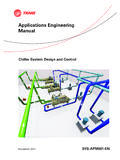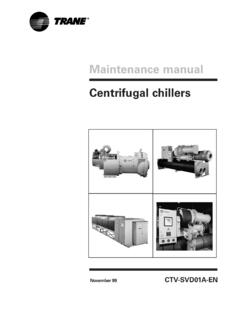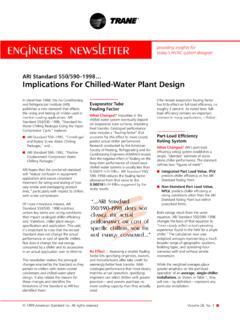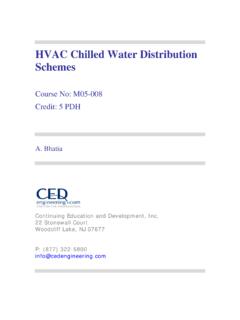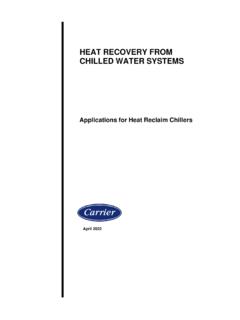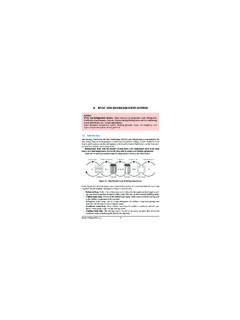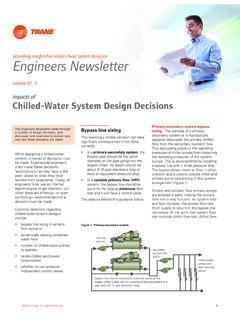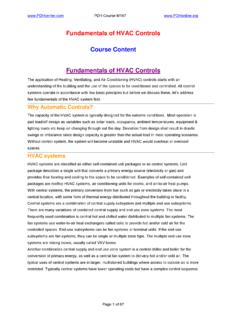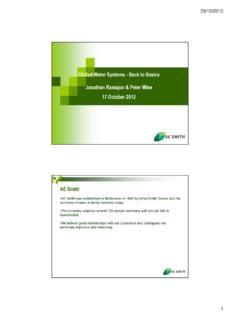Transcription of Chilled-Water Systems One of the Systems Series / Air ...
1 August 2012 TRG-TRC016-ENAir Conditioning ClinicChilled- water SystemsOne of the Systems SeriesChilled- water SystemsOne of the Systems SeriesA publication of TranePreface 2001 Trane All rights reservedTRG-TRC016-ENiiTrane believes that it is incumbent on manufacturers to serve the industry by regularly disseminating information gathered through laboratory research, testing programs, and field Trane Air Conditioning Clinic Series is one means of knowledge sharing. It is intended to acquaint a nontechnical audience with various fundamental aspects of heating, ventilating, and air conditioning.
2 We have taken special care to make the clinic as uncommercial and straightforward as possible. Illustrations of Trane products only appear in cases where they help convey the message contained in the accompanying particular clinic introduces the reader to Chilled-Water Trane Air Conditioning ClinicChilled- water SystemsFigure 1 TRG-TRC016-ENiiiContentsperiod oneTypes of water Chillers .. 1 Vapor-Compression water Chillers .. 3 Air-Cooled or water -Cooled Condensing .. 6 Packaged or Split Components .. 11 Absorption water Chillers .. 15 Equipment Rating Standards.
3 18period twoChilled- water System Design .. 26 Load-Terminal Control .. 28 Parallel Configuration .. 35 Series Configuration .. 38 Primary-Secondary System Operation .. 53period threeSystem Variations .. 59 Alternate Fuel Choice .. 59 Low-Flow Systems .. 61 Variable-Primary-Flow Systems .. 64 Preferential Loading .. 66 Heat Recovery .. 68 Asymmetric Design .. 72 Free Cooling .. 75 Application Outside the Operating Range of the Chiller .. 78period fourChiller-Plant Control .. 79 Chiller Sequencing .. 82 Failure Recovery and Contingency Planning .. 90 System Tuning.
4 92 System Optimization .. 96 Operator Interface .. 100period fiveReview .. 103 Quiz .. 108 Answers .. 110 Glossary .. 112ivTRG-TRC016-ENTRG-TRC016-EN1notesper iod oneTypes of water ChillersWater chillers are used in a variety of air conditioning and process cooling applications. They cool water that is subsequently transported by pumps and pipes. The water passes through the tubes of coils to cool air in an air conditioning system, or it can provide cooling for a manufacturing or industrial process. Systems that employ water chillers are commonly called Chilled-Water designing a Chilled-Water system, one of the first issues that must be addressed is to determine which type of water chiller to use.
5 This period discusses the primary differences in chiller refrigeration cycle is a key differentiating characteristic between chiller types. The vapor-compression and absorption refrigeration cycles are the two most common cycles used in commercial air oneTypes of water ChillersChilled- water SystemsFigure 2absorptionwater chillercentrifugalwater chillerFigure 32 TRG-TRC016-ENnotesperiod oneTypes of water ChillersWater chillers using the vapor-compression refrigeration cycle vary by the type of compressor used. Reciprocating, scroll, helical-rotary, and centrifugal compressors are common types of compressors used in vapor-compression water water chillers make use of the absorption refrigeration water chillers use a compressor to move refrigerant around the system.
6 The most common energy source to drive the compressor is an electric motor. Absorption water chillers use heat to drive the refrigeration cycle. They do not have a mechanical compressor involved in the refrigeration cycle. Steam, hot water , or the burning of oil or natural gas are the most common energy sources for these types of Sourcesheat-drivencompressor-drivenFigur e 4 TRG-TRC016-EN3period oneTypes of water ChillersnotesVapor-Compression water ChillersIn the vapor-compression refrigeration cycle, refrigerant enters the evaporator in the form of a cool, low-pressure mixture of liquid and vapor (A).
7 Heat is transferred from the relatively-warm air or water to the refrigerant, causing the liquid refrigerant to boil. The resulting vapor (B) is then drawn from the evaporator by the compressor, which increases the pressure and temperature of the refrigerant hot, high-pressure refrigerant vapor (C) leaving the compressor enters the condenser, where heat is transferred to ambient air or water at a lower temperature. Inside the condenser, the refrigerant vapor condenses into a liquid. This liquid refrigerant (D) then flows to the expansion device, which creates a pressure drop that reduces the pressure of the refrigerant to that of the evaporator.
8 At this low pressure, a small portion of the refrigerant boils (or flashes), cooling the remaining liquid refrigerant to the desired evaporator temperature. The cool mixture of liquid and vapor refrigerant (A) travels to the evaporator to repeat the vapor-compression refrigeration cycle is reviewed in detail in the Refrigeration Cycle Air Conditioning Cyclecompressorcompressorexpansionexpans iondevicedeviceenergy inenergy inabsorb heatabsorb heatreject heatreject heatevaporatorevaporatorcondensercondens erABCDF igure 54 TRG-TRC016-ENnotesperiod oneTypes of water ChillersThe type of compressor used generally has the greatest impact on the efficiency and reliability of a vapor-compression water chiller.
9 The improvement of compressor designs and the development of new compressor technologies have led to more-efficient and -reliable water reciprocating compressor was the workhorse of the small chiller market for many years. It was typically available in capacities up to 100 tons [350 kW]. Multiple compressors were often installed in a single chiller to provide chiller capacities of up to 200 tons [700 kW].Scroll compressors have emerged as a popular alternative to reciprocating compressors, and are generally available in hermetic configurations in capacities up to 15 tons [53 kW] for use in water chillers.
10 As with reciprocating compressors, multiple scroll compressors are often used in a single chiller to meet larger capacities. In general, scroll compressors are 10 to 15 percent more efficient than reciprocating compressors and have proven to be very reliable, primarily because they have approximately 60 percent fewer moving parts than reciprocating compressors. Reciprocating and scroll compressors are typically used in smaller water chillers, those less than 200 tons [700 kW]. Helical-rotary (or screw) compressors have been used for many years in air compression and low-temperature-refrigeration applications.
